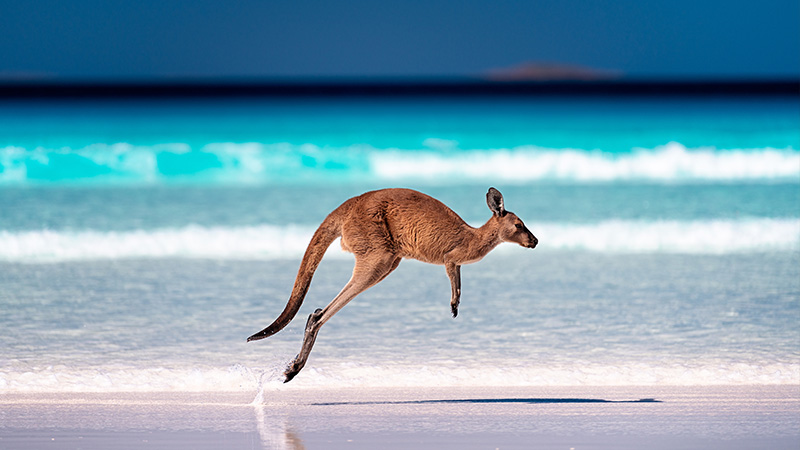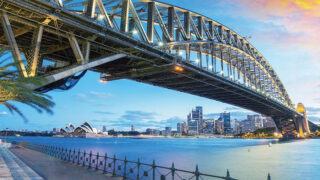Australia is well known for a few things: the Outback, the beaches, the accent, plus the fact that it’s the only country that’s also a continent. You can add Australian animals to this list too! The Australian land mass broke away from Gondwana and Antarctica tens of millions of years ago, leaving plenty of time for a quirky line-up of wildlife characters to evolve. The result is a whole host of animals you won’t find anywhere else, from the kangaroo and koala to the platypus and wombat. We take a look at a few of them here.
#1 Australia’s bouncy animal icon
Ask people who’ve never been to Australia to name one of its native animals, and you’ll invariably hear “kangaroo” as the answer. It’s not just appearing on the Qantas logo that gives this iconic creature its international clout. Kangaroos have many distinctive and memorable qualities – they’re the world’s largest marsupial, for one thing, and the only large animal in the world that hops. The biggest variety, the red kangaroo, can stand up to two metres tall, with a tail that adds well over a metre to its length. Oh, and it weighs as much as 90kg, too – when you add a hopping speed of almost 60 kilometres per hour to that, you’re looking at one powerful creature.

There are lots of them, too. Around 40 million, in fact. (Australia’s human population is only 26 million!) They’re not exactly roaming the streets like some first-time travellers expect to see, but you don’t have to drive for long out of any major city before you encounter one. Or a whole “mob” of them.
#2 Not every Australian animal will hurt you!
Lots will, though. Among the most dangerous are the 12 nasties listed here:
- Redback spider
- Irukandji jellyfish
- Eastern brown snake
- Blue-ringed octopus
- Cassowary
- Death adder
- Great white shark
- Box jellyfish
- Sydney funnel-web spider
- Red-bellied black snake
- Saltwater crocodile
- Reef stonefish
Fortunately, many of these are only very rarely encountered, and others have successful antivenom programs in place to help with stings and bites. We’re not saying you won’t encounter one of these beasties while living or travelling in Australia, but frankly, you’ll probably end up hating the flies more than anything.
By the way, if someone tries to warn you of “drop bears” – vicious, bloody-thirsty cousins of the koala that literally drop out of trees to attack passersby – they’re “having a lend of you” (Aussie slang for telling you a lie!).
#3 Weird and wonderful monotremes
At the turn of the 18th century, a team of scientists examining a preserved platypus body declared it to be a hoax: it was just bits of other animals sewn together, they said.
Fair enough, too. There’s nothing else on the planet like the platypus. This amphibious mammal has a duck’s bill, an otter-like body and fur, and a beaver-like tail. It’s also venomous, with an ankle spur that can deliver a fatal blow to small animals (or rival mates). It hunts using electroreception – same as a shark. Oh, and it lays eggs, making it one of only two monotremes (egg-laying mammals) in the world.
Of course, the other monotreme is also found only in Australia: the echidna. Echidnas are this country’s version of the porcupine or hedgehog, with a dose of anteater thrown in.
Both of these creatures and shy and reclusive, making them tricky to spot in the wild.
#4 Wait, is that bird laughing at me?
We’ve seen that there are some strange specimens on the land in Australia, but the country has some equally interesting creatures in the sky.
Best known among Australian birds is the kookaburra – which is actually the world’s largest variety of kingfisher. Its distinctive call is a cackling laugh, which is in fact a territorial cry. It’s usually heard coming from a whole flock either early in the morning or at dusk.
The opposite of a laughing kookaburra in Australia is the green catbird. It makes a sound that’s often described as like a crying child!
Other distinctive Australian birds including the cassowary (a giant walking bird that looks like it belongs in the pages of a dinosaur encyclopaedia), the fairy penguin (the world’s smallest penguin), the satin bowerbird (which collects blue objects to decorate its nest), as well as more hummingbird and parrot varieties than you’ll find anywhere on earth.
#5 Aussies eat their national animals
You’ll often hear people say that Australians are the only people who eat their coat of arms. While it’s true that the two animals featured on the national crest – the kangaroo and the emu – both appear on menus from time to time in this country, we shouldn’t get too excited about the claim. There’s a chicken on the Kenyan coat of arms, after all! What’s more, neither kangaroo nor emu is a mainstream meat – for many people, eating them still feels like something of a novelty. (Some people are put off by having grown up with a cute TV kangaroo called Skippy…) Of course, they were a regular part of the diet of Indigenous Australians.
In case you were wondering, kangaroo is a little like lean beef, albeit with a stronger, gamier flavour – not unlike venison. It’s usually served rare or medium rare to prevent it drying out. Emu meat, meanwhile, is even closer to beef, with a darker richer appearance.
5 more facts about Australian animals
- Only found on Rottnest Island near Perth, quokkas are known for their incredible cuteness and for their ability to “photobomb” a selfie. (Just google “Quokka selfie” and you’ll see what we mean…)
- The thylacine or Tasmanian tiger is sadly extinct, with the last known specimen dying in 1936. The Tasmanian devil lives on, however! The latter is a small carnivorous marsupial about the size of a small dog.
- May to November is a great for viewing whales off the Australian coastline as they migrate north to warmer waters to mate and give birth, before returning south. Australia even has a celebrity whale, which is sighted most years off the east coast: a white albino humpback called Migaloo.
- There have been a number of disastrous introduced species to Australia, but arguably the worst was the cane toad. 102 of these toads were brought here from Central America in 1935 to eat beetles that were feasting on local sugar cane. They clearly loved the place, as there are now an estimated 200 million of them.
- Another “cutie” in the line-up of Australian animals is the wombat. Yet while they’re generally portrayed as rotund and mellow, they can hit a surprising top running speed of 40 kilometres per hour!
24 great zoos, sanctuaries and parks for seeing Australian wildlife up-close
- Taronga Zoo, Sydney, NSW
- Warrawong Wildlife Sanctuary, SA
- Underwater Observatory, Busselton, WA
- Australia Zoo, Sunshine Coast, QLD
- Crocosaurus Cove, Darwin, NT
- Sea Life Sydney Aquarium, NSW
- Weribee Open Range Zoo, VIC
- National Zoo and Aquarium, Canberra, ACT
- Lone Pine Koala Sanctuary, Brisbane, QLD
- Perth Zoo, WA
- Featherdale Wildlife Park, NSW
- Koala Conservation Reserve, Phillip Island, VIC
- Alice Springs Desert Park, NT
- Taronga Western Plains Zoo, Dubbo, NSW
- Aquarium of Western Australia, Perth, WA
- Melbourne Zoo, VIC
- Hartley’s Crocodile Adventures, Cairns, QLD
- Symbio Wildlife Park, NSW
- Penguin Parade, Phillip Island, VIC
- Currumbin Wildlife Sanctuary, Gold Coast, QLD
- Healesville Sanctuary, VIC
- Sydney Zoo, NSW
- Bonorong Wildlife Sanctuary, TAS
- Ningaloo Discovery Centre and Aquarium, WA
Want to read more? Now find out about Australia’s native plants!

